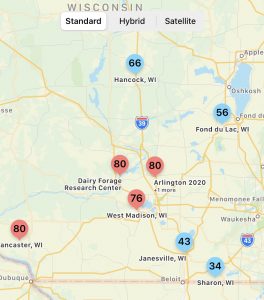Wisconsin Corn Tar Spot Update – July 14, 2020
Damon Smith, Extension Field Crops Pathologist, Department of Plant Pathology, University of Wisconsin-Madison
Roger Schmidt, Nutrient and Pest Management Program, University of Wisconsin-Madison
Last week brought our first detect of tar spot in Wisconsin for the 2020 field season. This week we are seeing more counties being added now in Iowa and Indiana, with some additional non-confirmed reports from southwest Wisconsin. Figure 1, show the location of the confirmed detections, which are all in the previously recorded range of the tar spot pathogen.

Figure 1. Corn IpmPIPE tar spot confirmations for U.S. Counties as of July 14, 2020. Grey shading indicates past confirmation in the county. Orange shading indicates a positive confirmation for 2020.

Figure 2. Tar Spot risk for various locations in Wisconsin for July 14, 2020.
Figure 2 shows the calculated risk from Tarspotter (our smartphone prediction tool for tar spot) for July 14, 2020, for various locations in Wisconsin. Figure 3 shows the risk for locations in southern and south-central Wisconsin. The action threshold for high risk is 75% using the updated Tarspotter model for 2020. As you can see, the present risk is elevated in much of the southern and southwestern portion of the state, the areas where reports are coming in. This is due to the fact that the weather continues to be relatively wet and humid for the past 30 days with decent rainfall. Cooler conditions this week are also contributing to the rising risk. Tar spot is favored by persistent temperatures between 60 and 70 F and high relative humidity averaging above 75% for a 30-day period, accompanied by extended periods of leaf wetness caused by dew, rain, or irrigation events. The newest Tarspotter tool captures all of these aspects and balances these in the calculations of risk in the map above.
The Recommendation

Figure 3. Tar spot risk for the southern and south-central zones of Wisconsin for July 14, 2020.
Tassels are starting to peek or are out in the southern portion of the state. We are now in the window of opportunity for a fungicide application if you feel the risk for disease, including tar spot, is warranted. Do some scouting and check weather reports. If it is dry in your area and has been hot, then no disease may be present. You might be able to hold off on that fungicide application. If it has been humid and rainy and you have some disease present in the lower canopy, then a fungicide application might be warranted. See my previous post for more information about making the decision to spray fungicide on corn.
More Tar Spot Information





